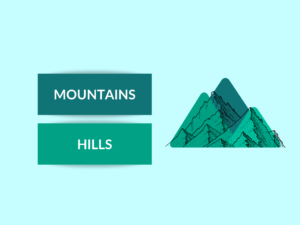Mountain vs Plateau: Understanding the Differences
What is a Mountain?
A mountain is a large landform that rises above the surrounding land in a limited area, usually with steep slopes and a peak. They are formed through tectonic forces or volcanic activity and are known for their majestic peaks and stunning landscapes.
Examples of Mountains
– Mount Everest: Located in the Himalayas, it is the highest mountain on Earth, standing at 8,848 meters (29,029 feet) above sea level.
– Mount Kilimanjaro: This dormant volcano in Tanzania is the highest mountain in Africa, famous for its snow-capped peak.
– Rocky Mountains: Stretching across North America, these magnificent mountains offer breathtaking views and diverse wildlife.
Uses of Mountains
Mountains have numerous uses and benefits, including:
1. Tourism and Recreation: Mountains attract adventure seekers, hikers, climbers, and nature enthusiasts, boosting local economies.
2. Freshwater Source: Mountains serve as natural water towers, providing freshwater for rivers and lakes downstream.
3. Biodiversity Hotspots: Mountains support unique ecosystems with diverse flora and fauna, promoting conservation efforts.
4. Energy Production: Many hydroelectric power plants are built on rivers originating from mountain ranges.
5. Cultural and Spiritual Significance: Mountains often hold cultural and religious value for communities around the world.
What is a Plateau?
A plateau is a flat, elevated landform characterized by its relatively flat top surface that stretches over a wide area. Unlike mountains, plateaus have gentle slopes or cliffs only on their edges and are often formed by the uplift of the Earth’s crust or volcanic activity.
Examples of Plateaus
– Colorado Plateau: Situated in the western United States, this plateau is renowned for its stunning geological features like the Grand Canyon.
– Deccan Plateau: Covering a significant portion of India, this plateau boasts various ancient forts, temples, and diverse cultural heritage.
– Tibetan Plateau: Often called “the Roof of the World,” it is the highest and largest plateau globally, covering vast areas in Tibet and neighboring regions.
Uses of Plateaus
Plateaus offer several advantages and applications, including:
1. Agriculture: The flat terrain of plateaus provides fertile soil for crop cultivation and supports agricultural activities.
2. Transportation: Plateaus with gentle slopes are often used for constructing roads, railways, and airports.
3. Settlements: Humans tend to establish settlements on plateaus due to their advantages for defense, agriculture, and accessibility.
4. Mining and Minerals: Many plateaus contain mineral deposits like coal, iron, and copper, providing valuable resources.
5. Scientific Research: Scientists study plateaus for various purposes, such as understanding geological processes or examining climatic patterns.
Differences between a Mountain and a Plateau
| Difference Area | Mountain | Plateau |
|---|---|---|
| Definition | A large landform rising above the surrounding area with steep slopes and a peak. | An elevated flat landform with a relatively flat top surface over a wide area. |
| Formation | Formed through tectonic forces or volcanic activity. | Result of uplift or volcanic activity, often over a long period. |
| Elevation | Varies, can reach extreme heights. | Relatively low elevation compared to mountains. |
| Slope | Steep slopes are common. | Gentle slopes or cliffs only at the edges. |
| Size | Smaller landform. | Generally larger landform. |
| Appearance | Majestic peaks, rugged terrain. | Flat top surface, often surrounded by cliffs. |
| Water Features | May have rivers, lakes, and glaciers. | Rarely have significant water bodies. |
| Fertile Soil | Often have limited fertile soil. | Can have extensive areas of fertile soil. |
| Uses | Tourism, freshwater source, biodiversity, energy production, cultural and spiritual significance. | Agriculture, transportation, settlements, mining, scientific research. |
| Examples | Mount Everest, Mount Kilimanjaro, Rocky Mountains. | Colorado Plateau, Deccan Plateau, Tibetan Plateau. |
Conclusion
In conclusion, mountains and plateaus are distinct landforms with unique characteristics. Mountains are defined by their steep slopes, peaks, and stunning landscapes, while plateaus feature flat top surfaces and cover vast areas. These differences impact their formations, elevations, appearances, and various uses.
People Also Ask
1. What is the highest mountain in the world?
Mount Everest, located in the Himalayas, holds the title of the world’s highest mountain.
2. Are plateaus always flat?
While the flat top surface is a defining characteristic, plateaus can have gentle slopes or cliffs only at their edges.
3. What are some popular mountain ranges?
Some well-known mountain ranges include the Himalayas, Andes, Alps, Rockies, and Sierra Nevada.
4. Can plateaus be located near mountains?
Yes, plateaus can often be found adjacent to or surrounded by mountains.
5. Why are mountains considered natural attractions?
Mountains offer awe-inspiring beauty, recreational activities, unique flora and fauna, and serve as sources of freshwater.


